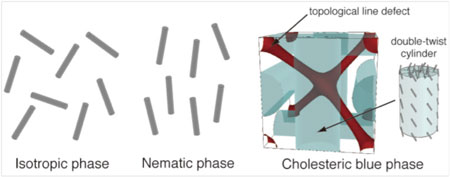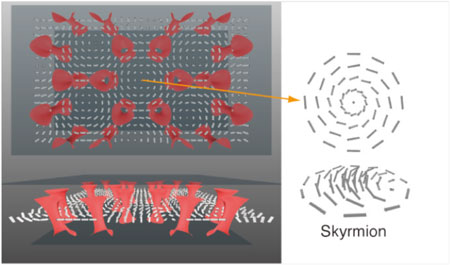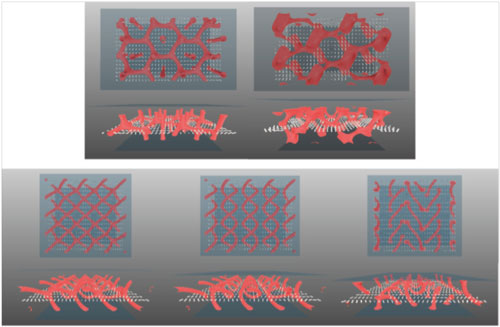| Apr 20, 2011 |
Discovery of new ordered structures of a liquid crystal
|
|
(Nanowerk News) Jun-ichi Fukuda, Soft Matter Modeling Group, Nanosystem Research Institute of the National Institute of Advanced Industrial Science and Technology (AIST), and Slobodan Zumer of the University of Ljubljana/Jozef Stefan Institute, Slovenia, found theoretically that a regular lattice of Skyrmions, whose role in solid state systems such as ferromagnets has been attracting great interest, can form in a thin confined liquid crystal, a system completely different from solid state systems.
|
|
This fact not only sheds new light on the relation between completely different systems, liquid crystals and solid state systems, but also demonstrates that liquid crystals can show much wider variety of intriguing ordered structures than what have been already known. New functions and applications of liquid crystals may be expected from these new structures.
|
|
This result was published online in Nature Communications on March 23.
|
|
Social Background of Research
|
|
Liquid crystals are widely used in various devices including TV displays and cellular phone displays due to their unique optical properties that can be easily controled. Most of such devices utilize the change in the optical properties of a nematic phase (a phase of liquid crystals in which molecules align in one direction) by applying an electric field.
|
|
Recently, different types of ordered phases of liquid crystals referred to as cholesteric blue phases (Fig.1) have been attracting interests. Cholesteric blue phases are complex three-dimensional ordered structures of chiral liquid crystals, and exhibit different optical properties from those of nematic liquid crystals. There have been attempts to utilize these unique optical properties of cholesteric blue phases in practical applications such as displays and lasers. The reasons for seeking the possibility of their use in displays include their fast response to an electric field and easier manufacturing processes; treatment of panel surfaces is simpler than that of conventional LC displays using nematic liquid crystals. Understanding basic properties of cholesteric blue phases is essential to applications, for which a considerable research effort has been made.
|
 |
| Figure 1: Schematic illustrations of isotropic, nematic, and cholesteric blue phases. Cholesteric blue phases are made up of double-twist cylinders and topological line defects interwoven intricately.
|
|
History of Research
|
|
AIST has been carrying out theoretical research based on continuum simulations aiming at the understanding of the properties of cholesteric blue phases and their behaviors in various situations, for example under an electric field, in practical applications. Since 2009, AIST, in collaboration with the University of Ljubljana and Jožef Stefan Institute, has been investigating the ordered structures of liquid crystals exhibiting cholesteric blue phases when they are confined in a thin space.
|
|
Details of Research
|
|
In this study, we focused on a thin liquid crystal whose thickness is of the order of 50 to 200 nanometers, much smaller than that of liquid crystals in conventional LC displays (several micrometers) and investigated its behaviors at the temperature close to the transition points between cholesteric blue phases and an isotropic phase. We expected that thin confined liquid crystals would behave as a quasi two-dimensional system substantially different from cholesteric blue phases whose intrinsic structures are three-dimensional and that topological defects would be easier to generate in liquid crystals close to the transition points, facilitating the formation of new ordered structures.
|
|
Indeed, we have found various new stable ordered structures of liquid crystals completely different from those already known (Figs. 2 and 3). Which structure is the most stable depends sensitively on temperatures and the thicknesses of liquid crystals. In particular, when the thickness of liquid crystals is smaller than the unit cell dimension of cholesteric blue phases and the temperature is sufficiently close to the transition point, a two-dimensional regular hexagonal lattice of Skyrmions was observed as a stable state (Fig. 2).
|
 |
| Figure 2: Skyrmion lattice obtained in the present study. Small cylinders represent orientational order of liquid crystals in the mid-plane, and red surfaces represent the position of topological defects.
|
 |
| Figure 3: Ordered structures other than Skyrmion lattices obtained in the present study.
|
|
A Skyrmion lattice with hexagonal symmetry was found in a thin film of chiral ferromagnets in which electron spins carry an orientational order. The Skyrmion lattice found in this study has similarities to the previous Skyrmion systems in the sense that both have hexagonal symmetry. However, these Skyrmion lattices are different due to the difference between the orientational order of liquid crystals and spin order in ferromagnets. These similarities and differences in structure shed new light on the relations between completely different systems, liquid crystals and solid state systems such as ferromagnets.
|
|
In contrast to Skyrmion lattices in ferromagnets, realization of Skyrmion lattices in liquid crystals does not require extreme conditions such as low temperatures, and liquid crystals will facilitate the study of the dynamics of Skyrmion lattices in response to external fields, such as an electric field or an imposed flow.
|
|
This study was supported by the Slovenian Research Agency, the Center of Excellence NAMASTE in Slovenia, and Grantin-in-Aid for Scientific Research on the Priority Area "Soft Matter Physics" from the Ministry of Education, Culture, Sports, Science and Technology of Japan.
|
|
Future Plans
|
|
Finding new ordered structures in liquid crystals may lead to the realization of new functions and applications of liquid crystals. Research on liquid crystals could provide new insight into other types of systems such as solid state systems. We will study the response of the newly found ordered structures of liquid crystals to an electric field and the changes in their optical properties, knowledge on which will be quite important for their possible applications.
|



